How would you look up information on species and natural history? Would you do a Google search or visit your local library? How about checking out the Biodiversity Heritage Library (BHL)! It’s the world’s largest virtual library of biodiversity heritage literature and archival materials and contains materials published as far back as the 1400s! This incredible resource contains information on millions of the world’s species. This information – the foundation of our understanding of biodiversity – is freely accessible online for everyone.
The Atlas of Living Australia in collaboration with Museums Victoria launched the Australian branch of the BHL in 2010. Since 2010, BHL Australia has grown from a single contributing organisation to 42, representing every state and territory across the country. Museums Victoria continues to host the project today BHL Australia staff and volunteers have now digitised over 500,000 pages of Australia’s biodiversity literature.
The knowledge in the BHL digitised pages includes scientific descriptions of Australia’s plants and animals and provides details of past distribution and abundance, allowing us to track changes across time. This information is invaluable to modern researchers, policy makers and educators.
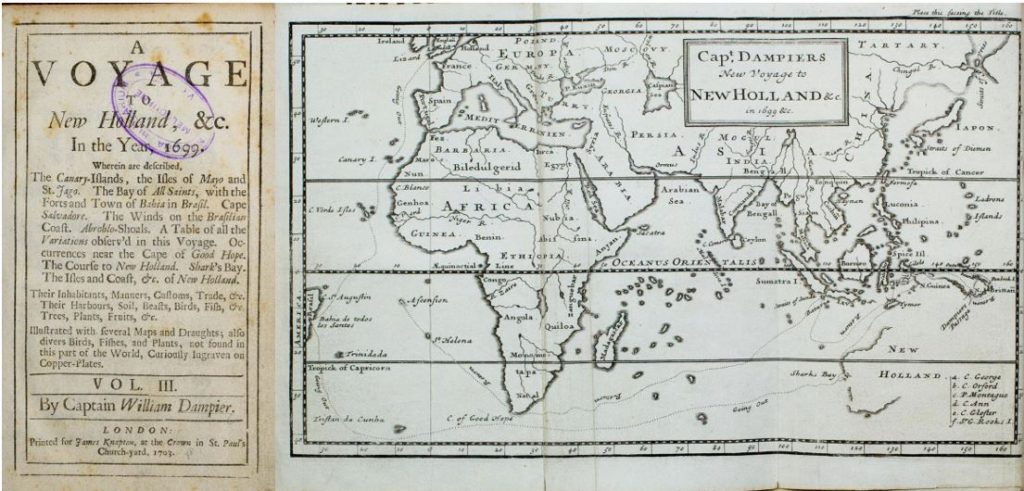
Caption: The oldest book in the BHL Australia collection is A voyage to New Holland in the year 1699 by William Dampier https://doi.org/10.5962/bhl.title.117049
One of the most significant publications made available on the BHL website is George Shaw’s The Naturalist’s Miscellany, from Museums Victoria’s Rare Book Collection. Shaw was an English naturalist and zoologist. His ground-breaking publication, The Naturalist’s Miscellany, consists of 24 volumes published in monthly instalments (fascicles) between 1789 and 1813. It contains scientific descriptions (in both English and Latin) of over 1000 species that were sent to London from around the world in the late 1700s and early 1800s. It covers an impressive range of species, including birds, mammals, reptiles, amphibians, insects, spiders, shells, and other marine organisms. Each description is accompanied by a spectacular illustration by Frederick Polydore Nodder, or, in the later volumes, his son Richard. Unprecedented in its scope and depth, The Naturalist’s Miscellany aimed to educate readers while highlighting the magnificence and diversity of nature.
Due to the timing of this significant work, The Naturalist’s Miscellany contains the first published scientific descriptions of many iconic Australian species, including (in 1790), the first scientific description of any species of kangaroo. At this time, the study of natural history was an esteemed academic pursuit backed by scientific rigour. George Shaw’s descriptions contain obvious awe and sometimes scepticism as he struggles fit Australia’s bizarre creatures into the current understanding of the natural world.
In Shaw’s description of the kangaroo, he notes the female is “furnished with a ventral pouch”. And his wonder just builds from here. He says:
The Kanguroo is a very anomalous and extraordinary quadruped…It is a creature of surprising agility, and springs forwards, by leaping to so uncommon a height, and to so great a distance, as to outstrip the fleetest pursuit; the swiftest greyhound being easily and soon distanced by this wonderful quadruped.
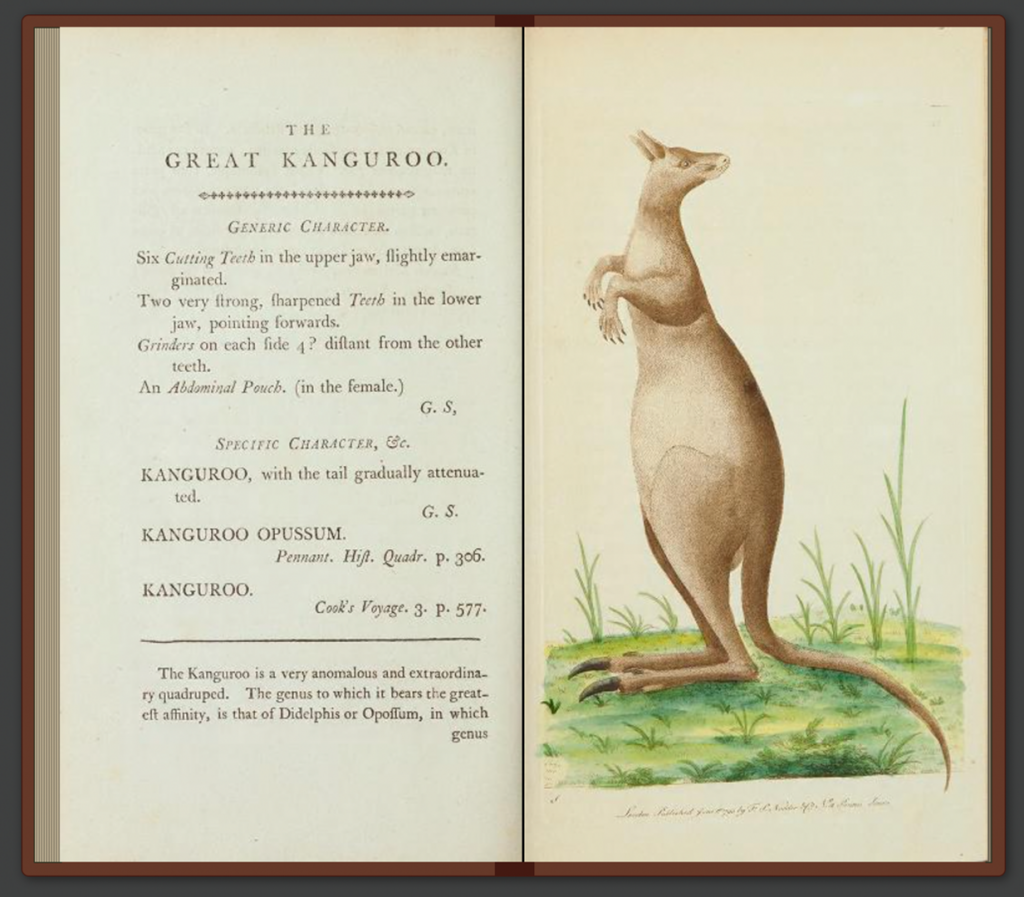
Caption: The Great Kanguroo, (Macropus giganteus) [Pl. 33] in Shaw, George (1790) The Naturalist’s Miscellany (vol. 1) https://doi.org/10.5962/p.310685
In 1792, Shaw introduced the echidna (the Porcupine Ant-Eater) to the wider world. He writes:
This extraordinary animal may well be considered amongst the most curious and interesting quadrupeds yet discovered …since it is not only an absolutely new and hitherto unknown species …but is also a most striking instance of that beautiful gradation, so frequently observed in the animal kingdom, by which creatures of one tribe or genus approach to those of a very different one.
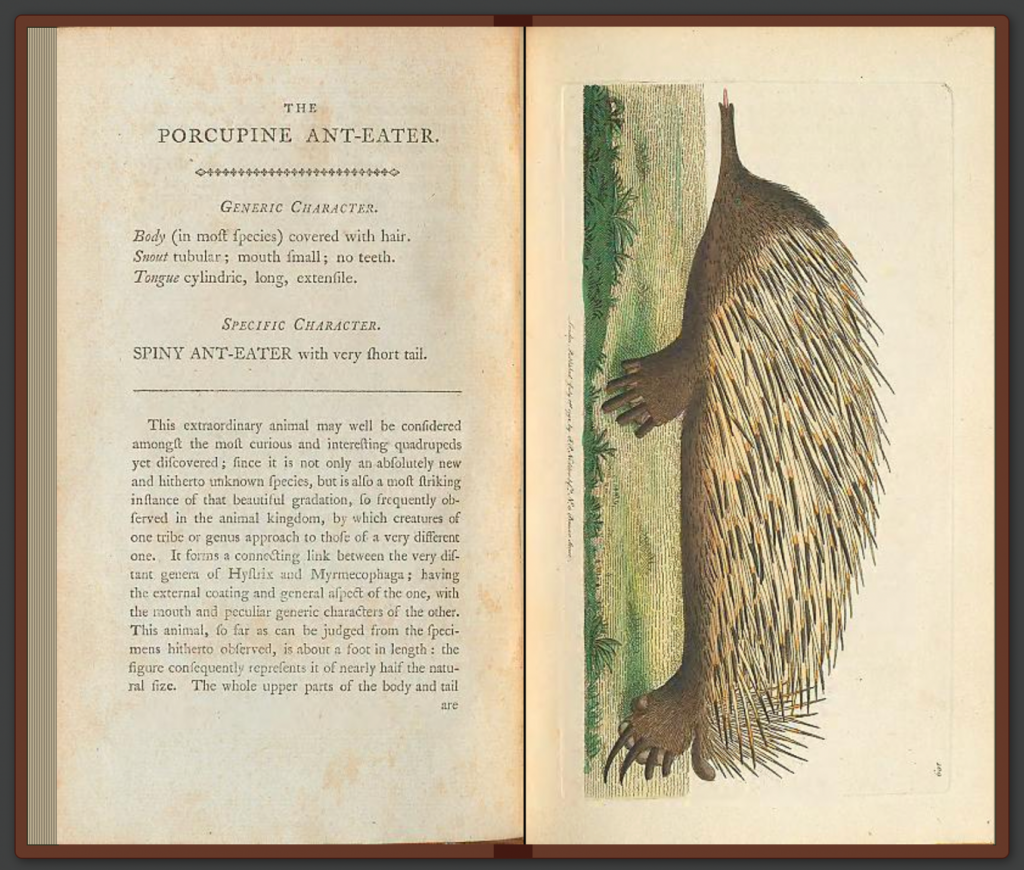
Caption: The Porcupine Ant-Eater, (Myrmecophaga aculeata) [Pl. 109] in Shaw, George (1792) The Naturalist’s Miscellany (vol. 3)
In 1799, George delivered the platypus’s international debut:
Of all the Mammalia yet known it seems the most extraordinary… the perfect resemblance of the beak of a duck engrafted onto the head of a quadruped…it naturally excites the idea of some deceptive preparation by artificial means.
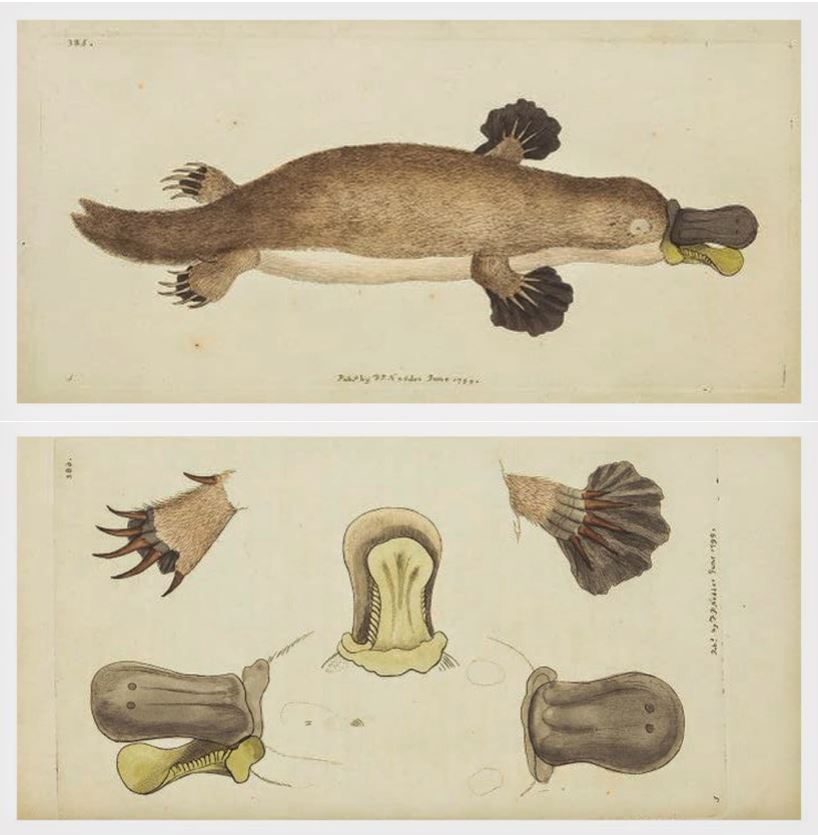
Caption: The Duck-Billed Platypus, (Platypus anatinus) [Pl. 385-386] in Shaw, George (1799) The Naturalist’s Miscellany (vol. 10) https://doi.org/10.5962/p.304567
So bizarre was this creature that Shaw questions whether it is indeed a real animal. The specimen Shaw based his description on is in Natural History Museum in London. If you were to examine this specimen, you would see the cuts around the bill made by Shaw in his efforts to find stitches. He was convinced the specimen was a hoax; that the bill of a duck had been sewn onto the body of something like a water rat. Shaw’s description of the platypus is one of only a few out of the 1000 that is accompanied by two plates. It seems that addition illustration – or perhaps proof – was required for those species that were truly perplexing.
The Naturalist’s Miscellany left an indelible legacy on the field of natural history. It played a vital role in the development of zoology as a discipline, providing an extensive compilation of species, many of which had not been previously documented. Shaw’s meticulous observations, combined with the detailed illustrations, enabled future naturalists and scientists to study and identify species with greater precision.
As we commemorate the International Day for Biological Diversity, the significance of this publication, and the historic literature as a whole, resonates deeply. The world is currently facing an unprecedented loss of species due to various factors, including habitat destruction, climate change, and other human activities. Some of the species described in The Naturalist’s Miscellany, such as the Great Auk and the Dodo, are now extinct.
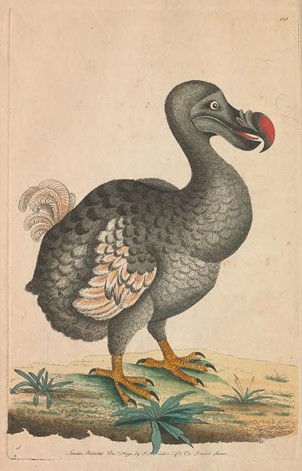
Caption: The Dodo, (Didus ineptus) [Pl. 123] in Shaw, George (1799) The Naturalist’s Miscellany (vol. 4) https://www.biodiversitylibrary.org/page/44515507
These examples serve as reminders of the irreversible loss that can occur when species are not adequately protected and conserved. They emphasise the importance of ongoing efforts to preserve and restore biodiversity to prevent further extinctions and maintain the delicate balance of ecosystems.
The Naturalist’s Miscellany is just one of the 180,000+ titles (60 million+ pages) made freely available on the BHL website by the 550+ contributing organisations across the world. What better way to spend International Day for Biological Diversity (May 22) than by exploring this invaluable resource.
BHL Australia acknowledges the traditional custodians of the land upon which we work: the Boon Wurrung and Woiwurrung peoples of the Eastern Kulin Nation. We would also like to acknowledge the First Peoples of every part of Australia because that acknowledgement is generally missing from the material we work with. The publications discussed in this article contain no acknowledgement that there were already people on these lands who had an extensive knowledge of both the biology and behaviour of these species.